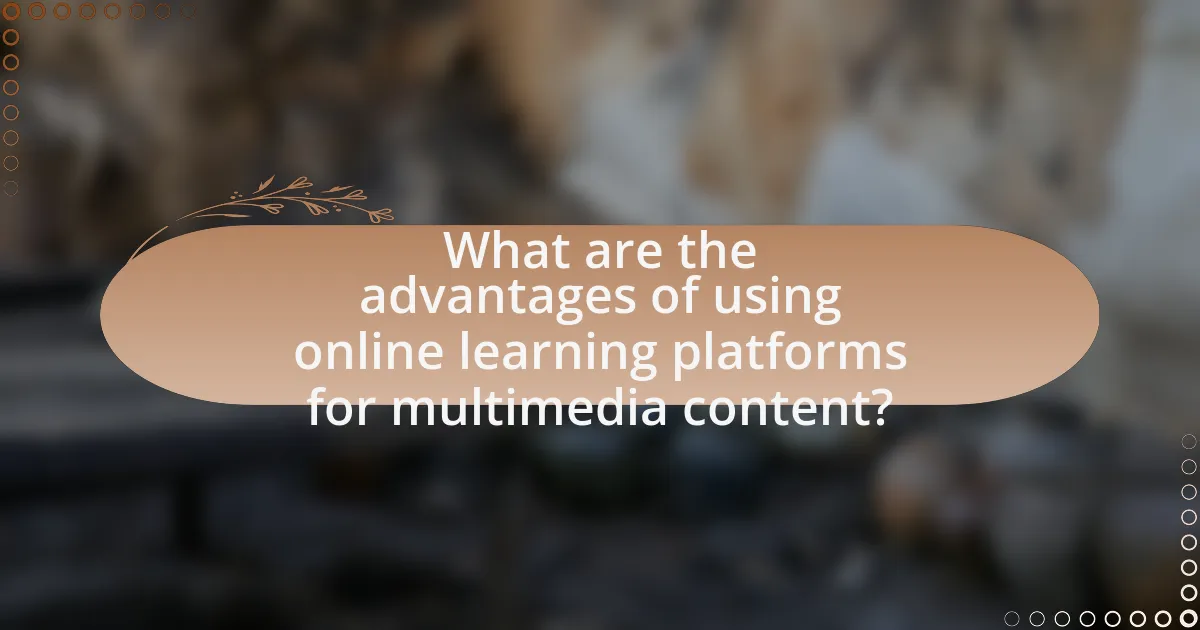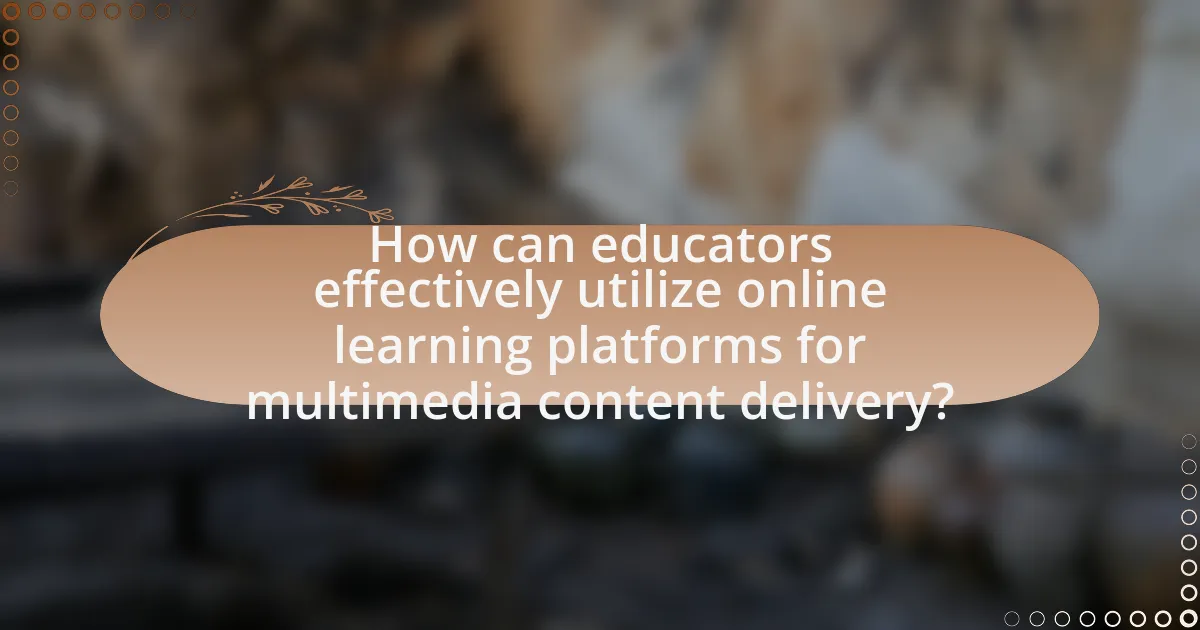The article focuses on comparing top online learning platforms for multimedia content delivery, specifically highlighting Coursera, Udemy, and LinkedIn Learning. It examines the differences in multimedia capabilities, types of content delivered, and the impact of user interfaces on learning experiences. Key features for comparison, such as pricing, customer support, and accessibility, are discussed, along with the advantages of using these platforms for engaging multimedia learning. Additionally, the article addresses challenges users face, strategies for effective content creation, and future trends in multimedia education.

What are the top online learning platforms for multimedia content delivery?
The top online learning platforms for multimedia content delivery are Coursera, Udemy, and LinkedIn Learning. Coursera partners with universities and organizations to offer courses that include video lectures, interactive quizzes, and peer-reviewed assignments, making it a comprehensive platform for multimedia learning. Udemy provides a vast library of courses with diverse multimedia formats, including video, audio, and text, catering to various learning styles. LinkedIn Learning focuses on professional development, offering high-quality video tutorials and courses that integrate multimedia elements to enhance the learning experience. These platforms are recognized for their effective use of multimedia to engage learners and facilitate knowledge retention.
How do these platforms differ in their multimedia capabilities?
The platforms differ in their multimedia capabilities primarily in terms of content variety, interactivity, and integration features. For instance, some platforms like Coursera offer a wide range of video lectures, quizzes, and peer-reviewed assignments, while others like Udemy focus more on video content with limited interactive elements. Additionally, platforms such as Skillshare emphasize project-based learning with multimedia projects, allowing for more hands-on experience. Integration capabilities also vary; platforms like LinkedIn Learning provide seamless access to LinkedIn profiles and job-related content, enhancing the multimedia experience. These differences highlight how each platform caters to diverse learning preferences and educational goals.
What types of multimedia content can be delivered on these platforms?
Online learning platforms can deliver various types of multimedia content, including video lectures, interactive quizzes, audio recordings, infographics, and text-based resources. Video lectures provide visual and auditory learning experiences, while interactive quizzes engage learners through assessments. Audio recordings cater to auditory learners, and infographics present complex information visually. Text-based resources, such as articles and e-books, supplement these formats, offering comprehensive learning materials. This diverse range of multimedia content enhances the educational experience by accommodating different learning styles and preferences.
How do user interfaces impact multimedia content delivery?
User interfaces significantly impact multimedia content delivery by influencing user engagement, accessibility, and overall learning experience. A well-designed user interface enhances navigation, allowing users to easily access various multimedia elements such as videos, audio, and interactive content. Research indicates that platforms with intuitive interfaces lead to higher user satisfaction and retention rates; for instance, a study by Nielsen Norman Group found that users are 50% more likely to engage with content when the interface is user-friendly. Additionally, effective user interfaces accommodate diverse learning styles, ensuring that multimedia content is accessible to a broader audience, which is crucial in online learning environments.
What are the key features to consider when comparing these platforms?
When comparing online learning platforms for multimedia content delivery, key features to consider include user interface, content variety, interactivity, scalability, and analytics capabilities. A user-friendly interface enhances learner engagement and accessibility, while a diverse range of content types (videos, quizzes, articles) caters to different learning styles. Interactivity features, such as discussion forums and live sessions, promote collaboration and deeper understanding. Scalability ensures the platform can accommodate growing user numbers without performance issues. Finally, robust analytics capabilities allow educators to track learner progress and engagement, facilitating data-driven improvements. These features collectively contribute to an effective and engaging online learning experience.
How does pricing affect the choice of an online learning platform?
Pricing significantly influences the choice of an online learning platform by determining accessibility and perceived value. Higher-priced platforms often promise more features, such as advanced multimedia content delivery, personalized learning experiences, and expert instructors, which can attract users seeking quality education. Conversely, lower-priced options may appeal to budget-conscious learners but might lack comprehensive resources or support. Research indicates that 70% of consumers consider price as a primary factor when selecting educational services, highlighting its critical role in decision-making. Thus, pricing not only affects user demographics but also shapes the overall market landscape for online learning platforms.
What role does customer support play in the effectiveness of these platforms?
Customer support is crucial for the effectiveness of online learning platforms as it directly impacts user satisfaction and retention. Effective customer support ensures that users can quickly resolve issues, access resources, and receive guidance, which enhances their overall learning experience. Research indicates that platforms with responsive customer support see higher user engagement and lower dropout rates, as timely assistance fosters a sense of community and trust. For instance, a study by the Online Learning Consortium found that 85% of students reported improved satisfaction when they received prompt support, highlighting the importance of customer service in maintaining platform effectiveness.

What are the advantages of using online learning platforms for multimedia content?
Online learning platforms offer significant advantages for multimedia content, primarily through accessibility, interactivity, and scalability. These platforms enable learners to access diverse multimedia resources, such as videos, podcasts, and interactive simulations, from anywhere with an internet connection, thus enhancing learning flexibility. Furthermore, the interactive nature of multimedia content fosters engagement and retention, as studies show that learners retain 25-60% more information when engaging with interactive elements compared to traditional methods. Additionally, online platforms can accommodate a large number of users simultaneously, making it easier to deliver content to a global audience without the constraints of physical classrooms.
How do these platforms enhance the learning experience?
These platforms enhance the learning experience by providing interactive and engaging multimedia content that caters to diverse learning styles. For instance, platforms like Coursera and Udemy utilize videos, quizzes, and discussion forums to facilitate active participation and deeper understanding. Research indicates that multimedia learning can improve retention rates by up to 60% compared to traditional methods, as highlighted in the study “The Effectiveness of Multimedia Learning: A Meta-Analysis” by Mayer (2014). This integration of various content types not only makes learning more enjoyable but also allows learners to grasp complex concepts more effectively.
What benefits do interactive multimedia elements provide?
Interactive multimedia elements enhance learning by increasing engagement, improving retention, and facilitating diverse learning styles. These elements, such as videos, animations, and interactive quizzes, actively involve learners, making the educational experience more dynamic. Research indicates that interactive content can boost information retention rates by up to 60% compared to traditional methods, as it encourages active participation and critical thinking. Furthermore, platforms that incorporate multimedia cater to various learning preferences, accommodating visual, auditory, and kinesthetic learners, thereby broadening accessibility and effectiveness in education.
How does accessibility impact learner engagement with multimedia content?
Accessibility significantly enhances learner engagement with multimedia content by ensuring that all learners, regardless of their abilities, can interact with and benefit from the material. When multimedia content is designed with accessibility in mind—such as providing captions for videos, screen reader compatibility, and alternative text for images—learners with disabilities can fully participate in the learning experience. Research indicates that accessible design not only aids those with disabilities but also improves usability for all users, leading to higher engagement rates. For instance, a study by the National Center on Disability and Access to Education found that accessible educational materials can increase retention and comprehension, thereby fostering a more inclusive and effective learning environment.
What challenges do users face when utilizing these platforms?
Users face several challenges when utilizing online learning platforms for multimedia content delivery, including technical issues, content accessibility, and engagement difficulties. Technical issues often arise from poor internet connectivity or platform compatibility, which can hinder the learning experience. Accessibility challenges include the lack of support for diverse learning needs, such as subtitles for hearing-impaired users or screen reader compatibility for visually impaired users. Engagement difficulties stem from the overwhelming amount of content available, which can lead to information overload and decreased motivation. According to a study by the Online Learning Consortium, 70% of students reported feeling overwhelmed by the volume of resources available on these platforms, highlighting the need for better content organization and user support.
How can technical issues affect multimedia content delivery?
Technical issues can significantly disrupt multimedia content delivery by causing delays, interruptions, or complete failures in accessing content. For instance, slow internet connections can lead to buffering during video playback, resulting in a poor user experience. Additionally, software incompatibilities may prevent certain multimedia formats from being displayed correctly, hindering the effectiveness of educational materials. According to a study by the Pew Research Center, 53% of online learners reported technical difficulties as a barrier to effective learning, highlighting the critical impact of these issues on content accessibility and engagement.
What are common user complaints regarding multimedia features?
Common user complaints regarding multimedia features include issues with video buffering, poor audio quality, and lack of interactive elements. Users frequently report that video content takes too long to load or frequently pauses, disrupting the learning experience. Additionally, audio problems such as low volume or unclear sound can hinder comprehension. Furthermore, many users express dissatisfaction with the absence of interactive features, such as quizzes or discussion forums, which can enhance engagement and retention. These complaints highlight the importance of reliable multimedia functionality in online learning platforms.

How can educators effectively utilize online learning platforms for multimedia content delivery?
Educators can effectively utilize online learning platforms for multimedia content delivery by integrating diverse multimedia resources such as videos, interactive simulations, and infographics into their teaching strategies. This approach enhances engagement and caters to various learning styles, as research indicates that multimedia learning can improve retention rates by up to 60% compared to traditional methods. Platforms like Moodle and Canvas offer tools for embedding multimedia content directly into course materials, allowing educators to create a more dynamic and interactive learning environment. Furthermore, analytics features on these platforms enable educators to track student engagement with multimedia content, facilitating data-driven adjustments to improve learning outcomes.
What strategies can enhance multimedia content creation?
Effective strategies to enhance multimedia content creation include utilizing storytelling techniques, incorporating interactive elements, and optimizing for various devices. Storytelling engages audiences by creating a narrative that resonates emotionally, which has been shown to improve retention rates by up to 65% (Branford & Johnson, 1972). Interactive elements, such as quizzes and polls, increase user engagement and participation, leading to a more immersive experience. Additionally, optimizing content for different devices ensures accessibility and usability, as 54% of online learners access content via mobile devices (Statista, 2021). These strategies collectively improve the quality and effectiveness of multimedia content in online learning environments.
How can educators assess the effectiveness of multimedia content?
Educators can assess the effectiveness of multimedia content by evaluating student engagement, comprehension, and retention rates. By analyzing metrics such as completion rates, quiz scores, and feedback surveys, educators can determine how well students interact with and understand the material. For instance, a study published in the Journal of Educational Technology & Society found that students exposed to multimedia content scored 20% higher on assessments compared to those who received traditional instruction, indicating a significant impact on learning outcomes. Additionally, educators can utilize tools like learning analytics to track user interactions and identify which multimedia elements contribute most to student success.
What tools are available for creating engaging multimedia content?
Tools available for creating engaging multimedia content include Adobe Creative Cloud, Canva, and Camtasia. Adobe Creative Cloud offers a suite of applications like Photoshop, Illustrator, and Premiere Pro, which are widely used for graphic design, video editing, and animation. Canva provides an accessible platform for users to create visually appealing graphics and presentations with a user-friendly interface and a vast library of templates. Camtasia specializes in screen recording and video editing, making it ideal for creating instructional videos and tutorials. These tools are recognized for their effectiveness in enhancing multimedia content creation across various online learning platforms.
What best practices should be followed when using these platforms?
When using online learning platforms for multimedia content delivery, best practices include ensuring content accessibility, engaging learners through interactive elements, and regularly updating materials. Accessibility is crucial as it allows all users, including those with disabilities, to benefit from the content; for instance, platforms should support screen readers and provide captions for videos. Engaging learners through quizzes, discussions, and multimedia elements enhances retention and understanding, as studies show that interactive content can increase learner engagement by up to 60%. Regularly updating materials ensures that the content remains relevant and accurate, which is essential in fast-evolving fields. These practices collectively enhance the effectiveness of online learning experiences.
How can educators ensure content is accessible to all learners?
Educators can ensure content is accessible to all learners by implementing universal design principles in their instructional materials. This approach includes providing multiple means of representation, engagement, and expression, which accommodates diverse learning needs. For instance, using captions for videos, alternative text for images, and offering content in various formats (text, audio, video) enhances accessibility. Research indicates that applying these principles can significantly improve learning outcomes for students with disabilities, as highlighted in the study “Universal Design for Learning: Theory and Practice” by Anne Meyer, David H. Rose, and Nicole Strangman.
What tips can improve learner interaction with multimedia content?
To improve learner interaction with multimedia content, incorporating interactive elements such as quizzes, polls, and discussion forums is essential. These features actively engage learners, prompting them to participate and reflect on the material. Research indicates that interactive multimedia can enhance retention and understanding; for instance, a study published in the Journal of Educational Psychology found that students who engaged with interactive content scored 20% higher on assessments compared to those who used passive learning methods. Additionally, providing clear navigation and user-friendly interfaces facilitates easier access to multimedia resources, further promoting engagement.
What are the future trends in online learning platforms for multimedia content delivery?
Future trends in online learning platforms for multimedia content delivery include increased use of artificial intelligence for personalized learning experiences, enhanced interactivity through virtual and augmented reality, and the integration of adaptive learning technologies. These trends are driven by the need for more engaging and effective educational experiences. For instance, a report by ResearchAndMarkets indicates that the global e-learning market is expected to reach $375 billion by 2026, highlighting the growing demand for innovative multimedia content delivery methods. Additionally, platforms are increasingly incorporating data analytics to track learner progress and tailor content accordingly, further supporting the trend towards personalized education.
How is technology shaping the evolution of multimedia learning?
Technology is significantly shaping the evolution of multimedia learning by enhancing accessibility, interactivity, and personalization in educational content. The integration of advanced tools such as artificial intelligence, virtual reality, and interactive platforms allows learners to engage with materials in dynamic ways, catering to diverse learning styles. For instance, studies show that the use of multimedia elements can improve retention rates by up to 60%, as learners are more likely to engage with content that combines text, audio, and visuals. Furthermore, platforms like Coursera and Udemy leverage technology to provide tailored learning experiences, enabling users to learn at their own pace and according to their individual preferences. This evolution is supported by research indicating that multimedia learning environments can lead to deeper understanding and better application of knowledge in real-world scenarios.
What innovations can we expect in multimedia content delivery?
Innovations in multimedia content delivery will include advancements in artificial intelligence, augmented reality, and adaptive learning technologies. Artificial intelligence will enhance personalization by analyzing user behavior to tailor content, improving engagement and retention rates. Augmented reality will provide immersive experiences, allowing learners to interact with 3D models and simulations, which has been shown to increase understanding and retention of complex subjects. Adaptive learning technologies will enable platforms to adjust the difficulty and type of content based on individual learner performance, ensuring a more effective learning experience. These innovations are supported by studies indicating that personalized and immersive learning environments significantly boost educational outcomes.